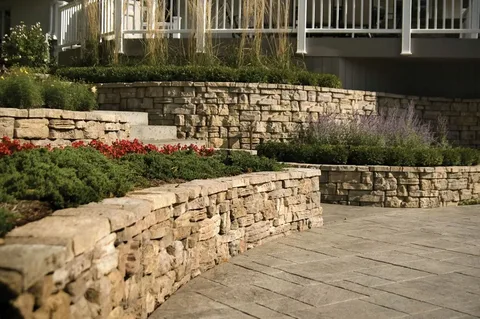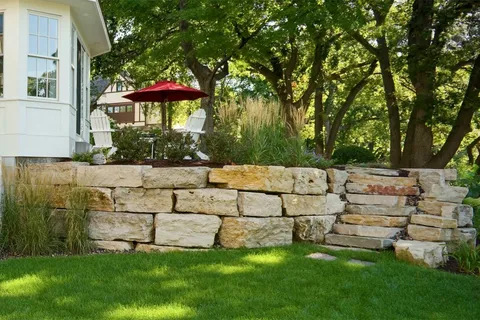Boulder retaining walls are a popular choice for homeowners creating a robust and aesthetic garden. These natural stone walls provide strength and durability and add a touch of beauty to any landscape. In this blog post, we will explore the basics of boulder retaining walls, their benefits, design considerations, installation tips, creative uses, maintenance, and care and showcase some successful case studies. Whether you want to enhance your garden’s functionality or simply want to elevate its visual appeal, Boulder Retaining Walls Brisbane are an excellent choice.
Understanding the Basics of Boulder Retaining Walls
Boulder retaining walls utilise stone’s natural strength and aesthetic appeal to manage sloped terrains effectively. These walls are constructed from large boulders strategically positioned and locked together, creating a barrier that prevents soil erosion and supports the land. The inherent durability of the materials used means these structures are built to withstand the elements, making them a steadfast solution for landscaping challenges.
One of the unique aspects of boulder retaining walls is their versatility in design. Each wall is bespoke, crafted from boulders with varying shapes and sizes, which can be selected to match a garden’s specific style and requirements. This allows for a highly personalised approach to landscaping, where functionality meets natural beauty. The process of building these walls involves meticulous placement and balancing of the stones, ensuring they are not only effective in their purpose but also visually appealing.
As a result, boulder retaining walls blend seamlessly with the surrounding environment, enhancing the natural topography while providing essential structural support. The choice of boulders, ranging from local varieties to specially sourced stones, further allows for customisation, giving each project a unique character and charm. This method of soil retention champions the use of natural materials, promoting an eco-friendly approach to garden design and landscaping.
 The Benefits of Choosing Boulder Retaining Walls for Your Garden
The Benefits of Choosing Boulder Retaining Walls for Your Garden
Opting for boulder retaining walls presents many advantages, paramount among which is their exceptional resilience. These walls stand the test of time, resisting weathering and erosion with remarkable efficiency, offering a steadfast solution for gardens in areas prone to such concerns. Unlike other materials that may degrade or require frequent replacement, boulders retain their structural integrity and aesthetic value over many years, making them a wise investment for the future.
Moreover, boulder retaining walls demand notably less upkeep. Their robust nature means they are less likely to succumb to common ailments afflicting other retaining wall types, such as cracking or bulging. This minimal maintenance requirement can significantly reduce long-term care costs, allowing homeowners to allocate their resources and efforts elsewhere in their gardens.
The aesthetic appeal of boulder retaining walls cannot be overstated. Each wall is a unique creation that can be tailored to complement the existing landscape, enhancing its natural beauty. The use of authentic stone offers a timeless elegance that integrates seamlessly with outdoor spaces, providing a striking visual contrast that can elevate the overall design of a garden.
Incorporating boulder retaining walls also opens up new garden layouts and usage possibilities. They enable the effective management of sloped areas, transforming previously unusable spaces into functional terraces or planting beds. This not only maximises the available gardening area but also introduces an element of structural diversity that can make outdoor spaces more engaging and versatile.
Design Considerations for Integrating Boulder Retaining Walls
When embarking on the integration of boulder retaining walls within your garden, attention to detail in the planning phase is paramount. The natural terrain’s gradient is critical in determining the wall’s structure and necessary support mechanisms to prevent soil erosion effectively. Selection of boulders is another aspect that requires thoughtful consideration. The choice should not only reflect the desired aesthetic outcome but also the practicality of the stones in terms of size, shape, and the ability to interlock securely for stability.
Engaging with an expert in landscape design or a seasoned contractor familiar with such projects is advisable. Their expertise can guide the selection process, ensuring that the boulders blend with the garden’s existing elements and contribute to the overall coherence of the landscape design. Furthermore, they can offer valuable insights into the engineering aspects, ensuring the wall is not only beautiful but structurally sound.
The wall’s visual impact should harmonise with the garden’s theme. Whether aiming for a rugged, natural look or a more refined, structured appearance, the choice of boulders can significantly influence the outcome. Additionally, considering how the wall will interact with existing or planned vegetation and garden features is crucial. This holistic approach to design ensures that the boulder retaining wall enhances the garden’s functionality while elevating its aesthetic appeal.
Installation Tips for Boulder Retaining Walls
Ensuring the successful establishment of boulder retaining walls hinges on meticulous preparation and organized installation. Commencing with the site preparation, excavating the area to a suitable depth and achieving a level base is imperative. This groundwork provides a solid foundation essential for the stability of the wall. During the installation, attention must be paid to the arrangement of boulders. They should be positioned to interlock naturally, with the larger stones at the base to anchor the structure securely. As the wall is constructed, incorporating smaller stones can fill gaps and add to the wall’s aesthetic diversity.
A critical, often overlooked aspect of installation involves implementing an effective drainage system. Positioning a layer of crushed stone or gravel behind the wall facilitates water movement away from the structure. This is crucial for preventing water pressure build-up that could compromise wall integrity.
For an enduring build, it is advisable to employ the expertise of professionals for the heavier and more complex aspects of construction. Their knowledge ensures that the wall not only serves its functional purpose but does so with longevity in mind. Employing these strategic approaches during the installation phase can significantly enhance the durability and appearance of boulder retaining walls, making them a lasting feature of the landscape.
Creative Ways to Use Boulder Walls Brisbane in Your Landscape
Boulder walls Brisbane landscapes can be ingeniously integrated beyond their traditional role of soil retention. Consider sculpting a serene rock garden that harmonises with the natural terrain, where boulders are both focal points and a foundation for various alpine and succulent plants. Alternatively, boulder walls can be used to craft an inviting pathway or steps through a sloping garden, blending functionality with aesthetic charm.
For those looking to add a tranquil water feature, strategically placed boulders can create natural-looking waterfalls or border serene pond settings, introducing a dynamic element to the garden’s soundscape. Additionally, creating informal seating areas or delineating distinct zones within the garden using boulder walls can transform an outdoor space into a versatile location for relaxation and entertainment.
Each of these creative applications not only utilises the structural robustness of boulder walls but also capitalises on their natural beauty, enhancing the overall landscape design whilst maintaining a connection with the natural world.
Maintenance and Care for Boulder Retaining Walls
Caring for boulder retaining walls, whilst generally straightforward, involves a few key practices to preserve their integrity and appearance over time. Conduct inspections at regular intervals, especially after severe weather conditions, to identify potential issues, such as shifts in the boulders or areas where erosion might occur. This proactive approach enables timely interventions, preventing minor problems from escalating into significant concerns.
The accumulation of debris, leaves, and soil can not only detract from the wall’s aesthetic appeal but also encourage moisture retention and the growth of vegetation, which could weaken the structure over time. Gently cleaning the wall’s surfaces and crevices, ideally with a soft brush or low-pressure water spray, will help maintain its natural beauty and structural integrity.
An often overlooked aspect of boulder wall maintenance is ensuring the effectiveness of the drainage system installed behind the wall. Periodic checks to confirm that drainage paths are clear and functioning correctly are crucial. This step helps to avoid water build-up, which can exert undue pressure on the wall, potentially leading to damage. Implementing these maintenance and care practices will significantly contribute to your boulder retaining walls’ longevity and visual appeal, keeping them stunning and sturdy features in your landscape for many years.
Case Studies: Successful Boulder Retaining Wall Projects
Exploring real-world applications of boulder retaining walls inspires potential projects. One remarkable example involves the transformation of a steeply sloped garden into a multi-level oasis. Boulder retaining walls were meticulously constructed to create terraced beds, each level blooming with a vibrant assortment of plants, seamlessly integrating functionality with natural beauty.
Another noteworthy project saw the utilisation of boulder retaining walls to forge a distinctive outdoor living space. Boulders were arranged to craft a circular seating area encircling a fire pit. This enhanced the garden’s charm and established a warm, inviting focal point for gatherings. These case studies illuminate boulder retaining walls’ diverse possibilities, from overcoming landscaping challenges to embellishing outdoor spaces with unique, enduring structures.
Conclusion
Embracing boulder retaining walls within one’s garden not only addresses the practical needs of soil retention and landscape management but also affords a splendid opportunity to infuse the outdoor space with natural elegance and resilience. The journey from concept to completion entails a nuanced understanding of the wall’s foundation alongside creative design and meticulous maintenance. In moving forward with such projects, one embarks on a path that leads to cultivating spaces that thrive in function and form, inviting an immersive experience of the outdoors that is both enriching and enduring.
FAQS
1. How long do boulder retaining walls last?
Boulder retaining walls are renowned for their longevity. A well-constructed wall can potentially last decades. Their durability primarily depends on the quality of construction and the environmental conditions they’re subjected to.
2. Do boulder retaining walls require planning permission?
This can vary depending on your local council regulations. It’s always advisable to check with your local planning authority before commencing any construction, as specific rules may apply, especially for walls above a certain height.
3. How much maintenance do boulder retaining walls need?
Compared to other types of retaining walls, boulder walls require minimal maintenance. Regular inspections and occasional cleaning to remove debris and ensure drainage efficiency are usually sufficient to maintain their condition.
4. Can I install a boulder retaining wall myself?
While it’s possible for smaller projects, professional expertise is recommended for larger, more complex installations. This ensures the wall is structurally sound and aesthetically pleasing.
5. Are boulder retaining walls environmentally friendly?
Using natural stone boulders means fewer manufacturing processes are involved, reducing the carbon footprint. Additionally, they can be sourced locally, further minimising environmental impact.
6. How are boulder retaining walls built on a slope?
Building on a slope requires careful planning and engineering to ensure stability. It often involves terracing or stepping the wall to conform to the landscape’s natural gradient while providing adequate drainage and erosion control.
| Other Good Articles to Read |
| Blogs-Nation |
| Blogs-Peoples |
| Bryan Smith Blogs |
| intellect blogs |
| the fault in our blogs |
| blogs eu |
| oz forums |
| recruitment blogs |
| zet blogs |
| id blogs |
| Blog Studio legale |
| blogs map |
| Related Business Listings |
| Contact Directory |
| Local Business Profiles |

